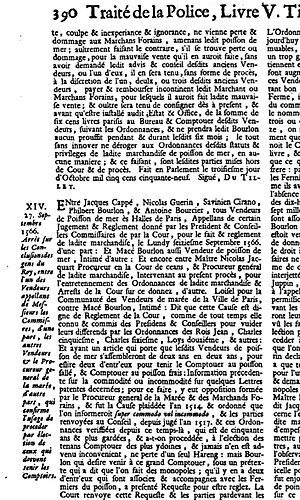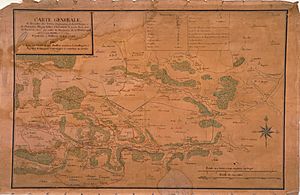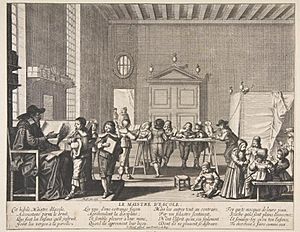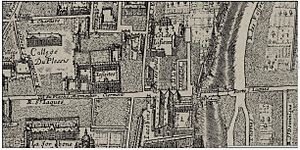Cyrano de Bergerac facts for kids
Quick facts for kids
Cyrano de Bergerac
|
|
|---|---|
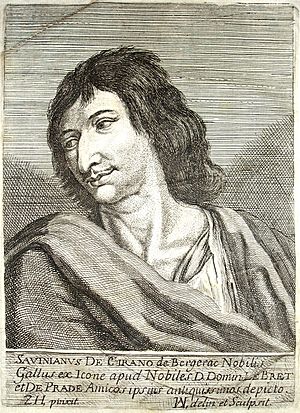
Bergerac illustrated by Zacharie Heince, c. 1654
|
|
| Native name |
Savinien de Cyrano de Bergerac
|
| Born | Savinien de Cyrano c. 6 March 1619 Paris, France |
| Died | 28 July 1655 (aged 36) Sannois, France |
| Occupation | Novelist, playwright, duelist |
| Language | French |
| Nationality | French |
| Period | 1653–1662 |
|
|
|
Savinien de Cyrano de Bergerac (/ˌsɪrənoʊ də ˈbɜːrʒəræk, - ˈbɛər-/ sirr-Ə-noh-_-də-_-bur, French: [savinjɛ̃ d(ə) siʁano d(ə) bɛʁʒəʁak]; 6 March 1619 – 28 July 1655) was a French novelist, playwright, writer of letters, and duelist.
He was a brave and creative author. His writings were part of a new style of literature in the 1600s. Today, he is most famous as the person who inspired Edmond Rostand's well-known play, Cyrano de Bergerac (1897). This play uses parts of his real life but also adds many made-up stories.
Since the 1970s, people have become more interested in studying Cyrano. Many books, essays, and biographies have been published about him in France and other countries.
Contents
Discovering Cyrano's Life
Cyrano lived a short life, and we don't have many records about him. We know some important parts of his life only from a special introduction. This introduction was in a book published in 1657, almost two years after he died. His friend, Henri Le Bret, wrote this introduction.
Without Le Bret, we wouldn't know about Cyrano's childhood in the countryside. We also wouldn't know about his time in the military or the injuries he got. Le Bret also told us about Cyrano's skill as a swordsman and how he died.
Since 1862, researchers have found more information about Cyrano. They looked at old church and legal records. This research helped us learn about his family and where he lived in Paris. However, these new documents don't change the main things Le Bret wrote.
Cyrano's Family Background
Savinien II de Cyrano was the son of Abel I de Cyrano. Abel was a lawyer in Paris. His mother was Espérance Bellanger. Her father was a King's Counselor and Treasurer.
His Grandparents
His grandfather, Savinien I de Cyrano, was likely from a well-known family in Sens, France. Records show he was a merchant in Paris. He also sold fish to the King. Later, he became a "Royal Counselor." He married Anne Le Maire in Paris in 1551. They had four children, including Abel, Cyrano's father.
We know less about his mother's father, Estienne Bellanger. He managed finances for Paris. His wife, Catherine Millet, came from an important family. Her grandfather, Guillaume I Millet, was a doctor to three French kings.
His Parents and Their Home
Espérance Bellanger and Abel I de Cyrano married on September 3, 1612. She was at least 26, and he was about 45. Their marriage contract shows they had connections to important families. These families were involved in finance, law, and even the royal court.
Abel de Cyrano had a library with 126 books. These books showed his interest in law and old languages. He also liked famous writers of his time. His library had books on science and different languages. It also included books by Protestant writers, suggesting he grew up in a Protestant environment.
His Brothers and Sisters
Espérance and Abel I had at least six children:
- Denis, born in 1614. He studied theology.
- Antoine, born in 1616. He died young.
- Honoré, born in 1617. He also died young.
- Savinien II (1619–1655), the writer.
- Abel II, born around 1624. He took over the family title after his father died.
- Catherine, who became a nun in 1641.
Growing Up
Childhood in the Countryside
In 1622, Abel de Cyrano moved his family from Paris. They went to live on his lands at Mauvières and Bergerac. These lands were in the Vallée de Chevreuse, a valley near Paris. He inherited these lands after his mother died.
The lands were located near the Yvette River. Savinien I de Cyrano, his grandfather, had bought them 40 years earlier. The estate of Mauvières had a house, stables, a barn, and a garden. The Bergerac estate next to it had another house and many acres of farmland and woods.
Savinien grew up in this country setting. He learned to read and write in a nearby church parish.
Teen Years in Paris
We don't know exactly when Savinien moved to Paris. He might have lived with his uncle Samuel de Cyrano. His parents had lived there before. This is where he might have met his cousin Pierre, who became his close friend.
He continued his studies at a school in Paris. For a long time, people thought he went to the Collège de Beauvais. His comedy Le pédant joué (The Pedant Tricked) is set there. But later, historians found he was a student at the Collège de Lisieux in 1641.
In 1636, his father sold the Mauvières and Bergerac lands. He moved back to Paris with his family. They lived in a small home near the Collège de Lisieux. It's not certain if Savinien lived with them.
Cyrano's Adventures and Writings
When he was 19, Cyrano joined a group of guards. He served in military campaigns in 1639 and 1640. As a young nobleman and officer, he was known for his dueling and boasting. His unique experiences helped him create special French art.
One author, Ishbel Addyman, suggests that Cyrano was not from Gascony. She says he was from Paris, and the name Bergerac came from a small estate near the city.
Cyrano is said to have left the military. He then returned to Paris to focus on writing. He wrote serious plays in the traditional style.
The character Roxane in Edmond Rostand's play Cyrano de Bergerac was inspired by Cyrano's cousin. She lived with his sister at a convent. Just like in the play, Cyrano did fight at the Siege of Arras in 1640. This was a battle during the Thirty Years' War. During the siege, he was wounded in the neck by a sword. One of his fellow soldiers was Baron Christian of Neuvillette, who married Cyrano's cousin. However, the love story between Roxane and Christian in Rostand's play is completely made up.
Cyrano was a student of Pierre Gassendi. Gassendi was a French scholar and priest. He tried to combine ancient ideas about atoms with Christian beliefs.
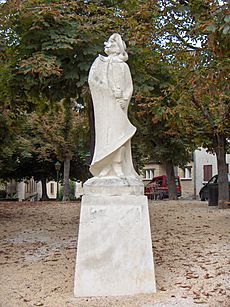
Cyrano de Bergerac wrote two famous books: L'Autre Monde: ou les États et Empires de la Lune (Comical History of the States and Empires of the Moon, published after his death in 1657) and Les États et Empires du Soleil (The States and Empires of the Sun, 1662). These are considered early examples of science fiction. In the first book, Cyrano travels to the Moon using rockets. He meets the Moon's inhabitants, who have four legs and special firearms. They also have talking earrings that teach children.
His mix of science and adventure in these books inspired many later writers. These included Jonathan Swift, Edgar Allan Poe, and probably Voltaire. Famous playwrights like Corneille and Molière even used ideas from Cyrano's play Le Pédant joué.
How Cyrano Died
The famous play suggests that Cyrano was hurt by a falling wooden beam in 1654. This happened when he was entering his patron's house. However, a researcher named Madeleine Alcover found an old text. This text suggests an attack on a carriage where someone from the Duke's household was injured. It's not fully clear if Cyrano's death was caused by this injury or by an illness. He died more than a year later, on July 28, 1655, at age 36. He was at his cousin Pierre De Cyrano's house in Sannois. He was buried in a church in Sannois.
Cyrano in Stories and Movies
Rostand's Play
In 1897, the French poet Edmond Rostand wrote a play about Cyrano's life. It was called Cyrano de Bergerac. This play became Rostand's most successful work. It tells the story of Cyrano's love for the beautiful Roxane. He has to help a handsome but less clever friend, Christian de Neuvillette, try to win her heart.
The play has been turned into operas and movies many times. It has also been rewritten in other book forms and as a ballet.
Other Authors' Works
- The Adventures of Cyrano De Bergerac by Louis Gallet was published in 1900. It is different from Rostand's play.
- Cyrano is a main character in the Riverworld book series by Philip José Farmer.
- Cyrano de Bergerac inspired the character Saint-Savin in Umberto Eco's novel The Island of the Day Before.
- In A. L. Kennedy's novel So I Am Glad, Cyrano de Bergerac appears in a modern-day house.
- In Robert A. Heinlein's novel Glory Road, a character similar to Cyrano fights.
- John Shirley wrote a story about Cyrano called "Cyrano and the Two Plumes."
- The novel Pyrotechnicon by Adam Browne is a sequel to Cyrano's science fiction stories.
- The Lost Sonnets of Cyrano de Bergerac by James L. Carcioppolo is a book of fictional poems.
- Cyrano de Bergerac is a main character in Charles Lecocq's 1896 comic opera Ninette.
Movies About Cyrano
Recently, a musical romantic drama called Cyrano was made. It was based on a stage musical. Peter Dinklage played Cyrano in the film. The movie received good reviews and was nominated for several awards.
There is also a popular French film, Cyrano de Bergerac, starring Gérard Depardieu. Other films include a 1925 film and a 1950 film.
See also
 In Spanish: Cyrano de Bergerac para niños
In Spanish: Cyrano de Bergerac para niños
- Asteroid 3582 Cyrano, named after de Bergerac


